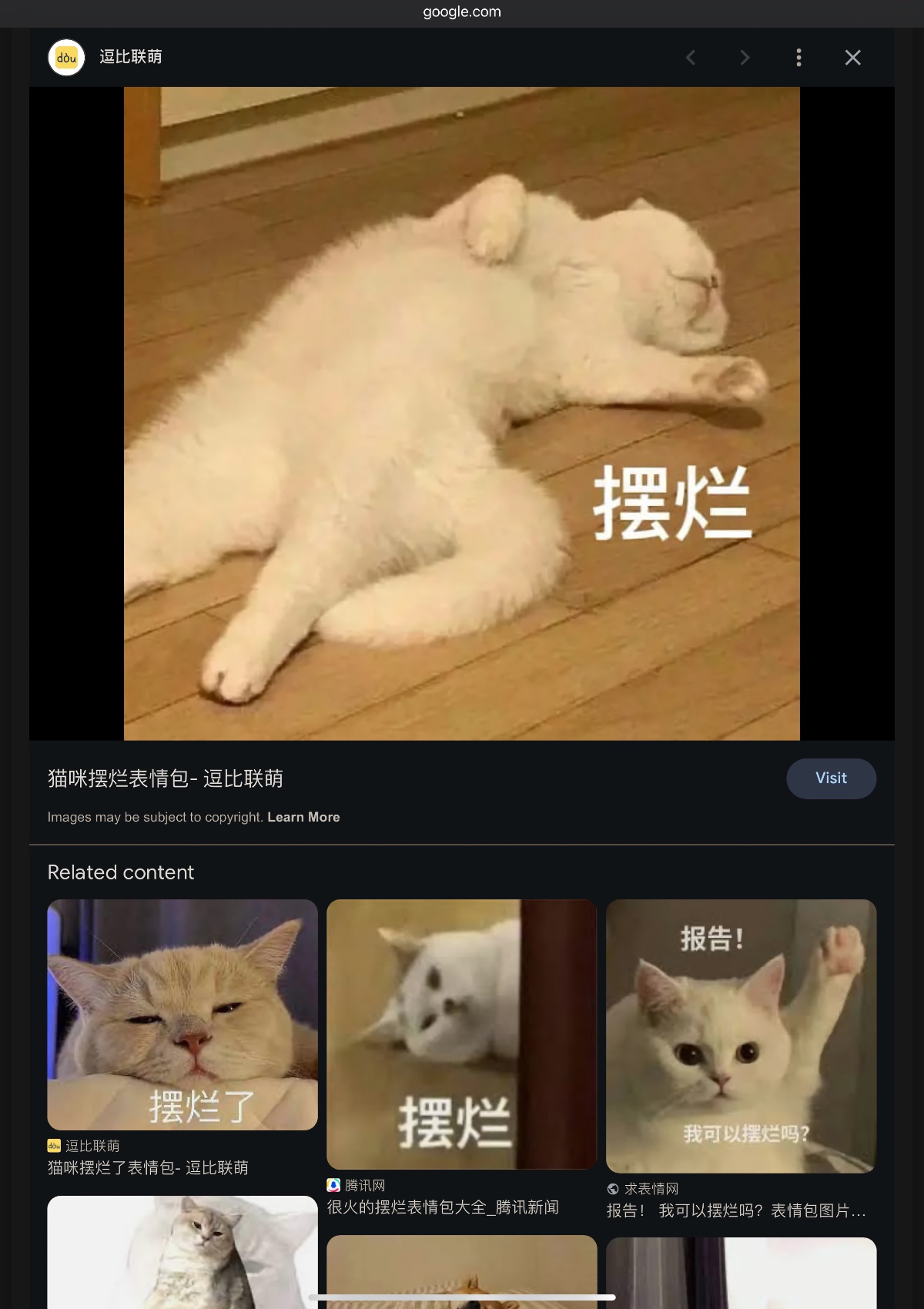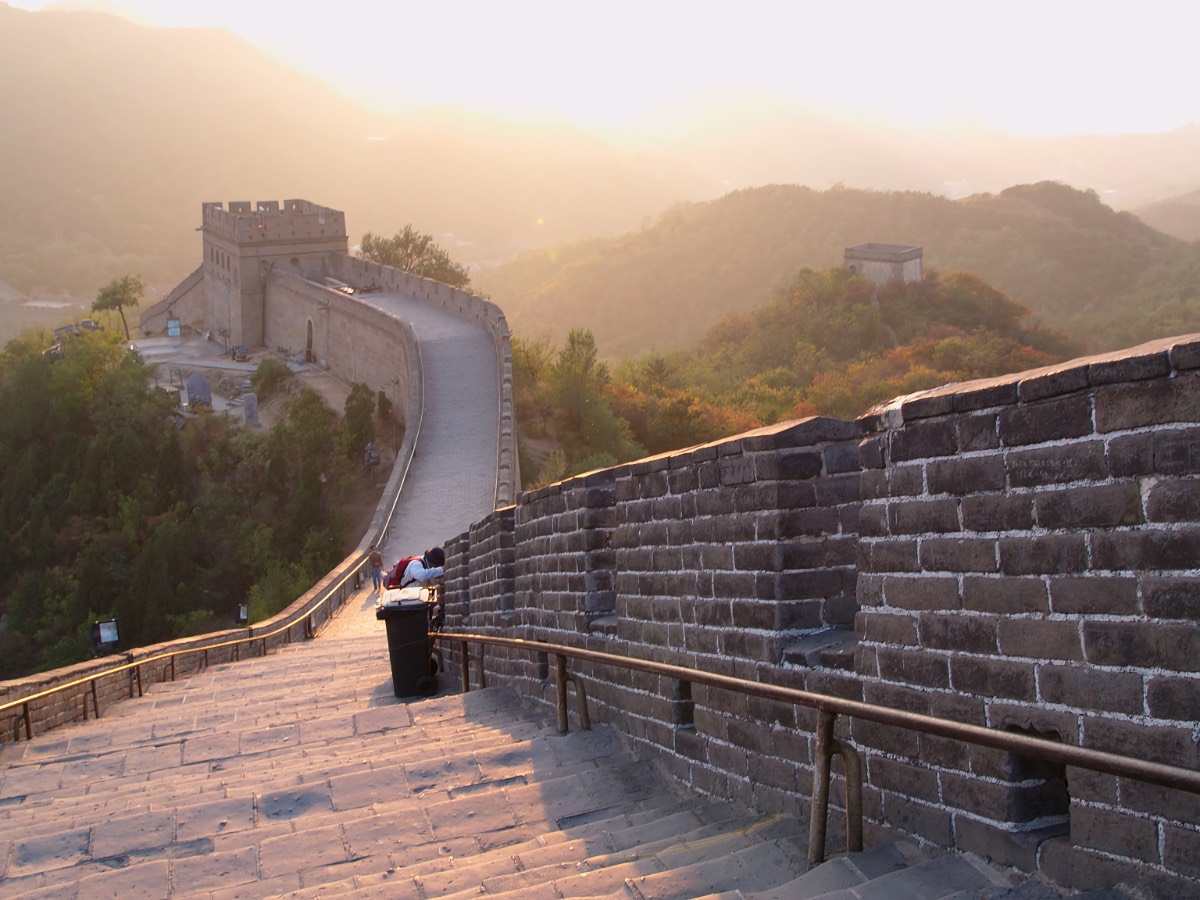bǎilàn (bǎi·làn {place; arrange → [assume; put on (air of) | exhibit; display]} · {being rotten; decayed; spoiled | worn out; broken; ragged; crappy | mushy} 摆烂 擺爛) ← Tap/click to show/hide the “flashcard”
In 2022, this week’s MEotW, “bǎilàn (bǎi·làn {place; arrange → [assume; put on (air of) | exhibit; display]} · {being rotten; decayed; spoiled | worn out; broken; ragged; crappy | mushy} 摆烂 擺爛)”, gained popularity among some young people in China as an expression that represents their approach to life in view of the difficult, even seemingly hopeless work culture, societal expectations, etc. that they are faced with. “Bǎilàn (Bǎi·làn {place; arrange → [assume; put on (air of) | exhibit; display]} · {being rotten; decayed; spoiled | worn out; broken; ragged; crappy | mushy} 摆烂 擺爛)” represents a progression beyond “tǎngpíng (tǎng·píng lie; recline · {[to be] flat} 躺平)”, a past MEotW—just compare the cats!

Some image results from searching for “摆烂” (“bǎilàn (bǎi·làn {place; arrange → [assume; put on (air of) | exhibit; display]} · {being rotten; decayed; spoiled | worn out; broken; ragged; crappy | mushy} 摆烂 擺爛)”) on Google
Reports from Around the Internet
Here are some of the many media reports about this expression:
The rise of ‘bai lan’: why China’s frustrated youth are ready to ‘let it rot’ | China | The Guardian
Here are some quotes from the above article:
In recent days, this phrase – and more previously ‘tang ping’ (lying flat, 躺平), which means rejecting gruelling competition for a low desire life – gained popularity as severe competition and high social expectations prompted many young Chinese to give up on hard work.
But bai lan has a more worrying layer in the way it is being used by young people in China: to actively embrace a deteriorating situation, rather than trying to turn it around.
…
Prof Mary Gallagher, director of the Centre for Chinese Studies at the University of Michigan, says ‘bai lan’ is not necessarily a sentiment unique to China. “It is a bit like the ‘slacker’ generation in America in the 1990s. And like ‘tang ping’ last year, it is also a rejection against the ultra-competitiveness of today’s Chinese society.”
…
More than 18% of young Chinese people aged between 16 and 24 were jobless in April – the highest since the official record began. “Hard to find a job after graduation this year? Fine, I’ll just bai lan – stay at home and watch TV all day,” wrote one netizen who struggled to find work, despite China’s top leader urged young people to fight for the future.
A new buzzword has entered the Chinese lexicon.
bailan 摆烂 “to let things rot.”
What does it mean? 1/7
— Chang Che (@Changxche) May 12, 2022
2021 was the year of tangping 躺平.
One by one, Chinese youths began to opt out of a system where additional effort no longer tracked additional rewards. In fact, the system was so overheated, rewards often decreased with added effort.
They called it “involution” 内卷. 2/7
— Chang Che (@Changxche) May 12, 2022
2022 is the year when Chinese chose to bailan.
Bailan means to actively embrace a bad situation (i.e. let it deteriorate further) rather than to try and flip it into a good one.
A similar Chinese idiom is 破罐破摔 referring to dropping a pot that’s already cracked. 3/7
— Chang Che (@Changxche) May 12, 2022
To lie flat is to stop striving and ascending. To go into a cruising altitude.
Bailan is more cynical.
It’s to let go of the wheel, and watch things crumble. To lean into one’s self-sabotage. 4/7
— Chang Che (@Changxche) May 12, 2022
Housing prices too high? Just forget it. You’ll never catch up. Just rent and embrace the rising rent costs.
Dating too exhausting? Then stop. Embrace being single and getting lonelier each year. 5/7
— Chang Che (@Changxche) May 12, 2022
Marriage too expensive? Then forget it. Why put yourself through the work of buying a car, owning a house, having good savings, and a high income.?
No room for career advancement? Just take extra holidays and laze around, let people down. 6/7
— Chang Che (@Changxche) May 12, 2022
“When guys got together in the past, all they talked about were girls. Now, all they do is talk about how great it is to be single. Is this societal progression or regression?”
– from a Chinese livestreamer. 7/7
— Chang Che (@Changxche) May 12, 2022
It’s been popular locally in Taiwan for quite a bit longer and across the Chinese basketball internet “擺爛” has been the unofficial translation for “tanking” – which is when a bad team stinks on purpose
— Pete Lee (@kungfupete) May 12, 2022
For a really deep dive into “bǎilàn (bǎi·làn {place; arrange → [assume; put on (air of) | exhibit; display]} · {being rotten; decayed; spoiled | worn out; broken; ragged; crappy | mushy} 摆烂 擺爛)”, check out this extended video news report from CNA, an English language news network based in Singapore:
“Letting It Rot” in the Mandarin Field?
Perhaps we can apply “bǎilàn (bǎi·làn {place; arrange → [assume; put on (air of) | exhibit; display]} · {being rotten; decayed; spoiled | worn out; broken; ragged; crappy | mushy} 摆烂 擺爛)” to how some may be resigned to being “crappy”, or at best mediocre, at the language-related aspects of being in the Mandarin field.
Some Mandarin field language learners have noticed that after an initial period of progress, they—and perhaps some/many of their fellow workers—may have plateaued, or leveled out in how good they are with the Mandarin language. Instead of moving on to a reasonable level of fluency or mastery, they may have gotten stuck for a long time at a “crappy” or at best mediocre level.
They may be resigned to this situation, or they may even actively embrace it, perhaps reasoning that the Great Wall of Characters is what it is, or that Mandarin just sounds too different from what they’re used to (e.g., with its tones), or that they personally just don’t have the intelligence or the talent to do any better. They may thus quit trying to do any better, or they may even quit the Mandarin field altogether. Such ones have effectively chosen to “bǎilàn (bǎi·làn {arrange → [exhibit]} · {being crappy} 摆烂 擺爛)” with regard to their Mandarin and their service in the Mandarin field.

Can we do better than to “bǎilàn (bǎi·làn {arrange → [exhibit]} · {being crappy} 摆烂 擺爛)” when faced with the Great Wall of Characters?
Note, though, that changing to focus on first principles of language rather than sticking to played out traditional learning methods can provide fuel and energy for progress beyond being “crappy” or just mediocre at using the Mandarin language in your service to Jehovah God and your Mandarin-speaking neighbours. For example, while traditional Chinese culture dictates that Mandarin learners must focus on learning the extraordinarily and unnecessarily complex Chinese characters, first principles of language–as illuminated by linguistics, the scientific study of language—hold that SPEECH is actually the primary aspect of any human language, not writing, even if that writing is as traditionally and culturally entrenched as Chinese characters are. Indeed, I can personally testify that I have found that changing focus from the traditionally mandated crazy-complex characters to Mandarin SPEECH, with the help of the simple and elegant Pīnyīn (Pīn·yīn {Piecing Together} · Sounds → [Pinyin] 拼音) writing system, is working to help me make noticeable ongoing progress in how much Mandarin I understand, and in how much I speak and sound like a native speaker of Mandarin.
Of course, such progress is personally satisfying, but as Jehovah’s dedicated servants and fellow workers, we should be even more concerned about how Jehovah views our efforts. Here are a couple of scriptures that may help us to understand Jehovah’s view of unnecessarily “crappy” or mediocre ‘sacrifices of praise’ (Hebrews 13:15) that some may offer in the Mandarin field:
6 “‘A son honors a father, and a servant his master. So if I am a father, where is the honor due me? And if I am a master, where is the fear due me?’ Jehovah of armies says to you priests who are despising my name.
“‘But you say: “How have we despised your name?”’
7 “‘By presenting polluted food on my altar.’
“‘And you say: “How have we polluted you?”’
“‘By saying: “The table of Jehovah is something to be despised.” 8 And when you present a blind animal as a sacrifice, you say: “It is nothing bad.” And when you present a lame animal or a sick one: “It is nothing bad.”’”
“Try presenting them, please, to your governor. Will he be pleased with you or receive you with favor?” says Jehovah of armies.
9 “And now, please, appeal to God, that he may show us favor. With such offerings from your own hand, will he receive any of you with favor?” says Jehovah of armies.
15 ‘I know your deeds, that you are neither cold nor hot. I wish you were cold or else hot. 16 So because you are lukewarm and neither hot nor cold, I am going to vomit you out of my mouth. 17 Because you say, “I am rich and have acquired riches and do not need anything at all,” but you do not know that you are miserable and pitiful and poor and blind and naked, 18 I advise you to buy from me gold refined by fire so that you may become rich, and white garments so that you may become dressed and that the shame of your nakedness may not be exposed, and eyesalve to rub in your eyes so that you may see.
We should also remember that moving beyond “crappiness” or mediocrity in our Mandarin can help us to be more able to give spiritual help to the people in the Mandarin field who looking for something beyond the crappiness and mediocrity of this old system of things, something beyond the selfish, materialistic, and ultimately meaningless rat race promoted by Satan’s world. These people need the good news of God’s Kingdom, and they need people like us to share it with them in a language that they will understand and respond to from the heart.—Mark 6:34.
